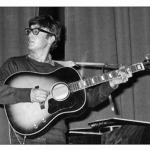This article is a brief history of the guitar, from its possible origins to the present. We should note that the origins and history that we discuss in this article is the origin, and it will be completed with the article of history of electric guitar.
The part of the story that we will see in this article is common for all types of guitar: acoustic, electric and classical or traditional, at least until the contemporary guitar on the twentieth century.
We can begin the article saying that the origins of the guitar are quite vague and we will not find the absolute truth about the origin of this instrument anywhere, although there is evidence of similar instruments many centuries ago.
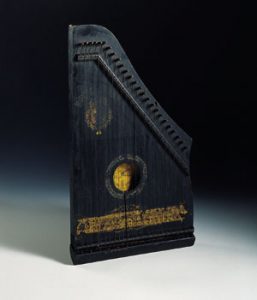
Some sources suggest that the Egyptians knew an instrument like guitar, which could be dated between 1600 and 1300 BC, but other sources point to the evidence of a four-stringed instrument, also like the guitar, during the Hittites era that could be dated at 1300 BC.
As for the Iberian Peninsula, many sources indicate that in Spain the first guitar-like instrument that appeared was the Arabic Ud, after the Muslim invasion in the south of the peninsula. Although this does not match with the data on the occurrence of the Roman zither on the peninsula centuries before.
The word Ud meant wood and had so much repercussion that in France that gave rise to the word luthier, word with which nowadays we denominate to the constructors of instruments.
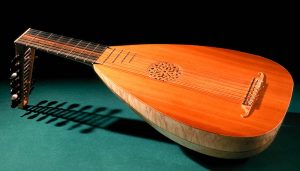
On the thirteenth century we find a typical classification for instruments that distinguishes between Moorish guitar, lute, and the Latin guitar, Guitar. At that time the four string instruments had evolved; on the one hand, the Latin guitar and vihuela were instruments that came from zither with a flat bottom and soundboard, and secondly, the Moorish guitar, lute, as the lira was with a rounded back, wide neck and several incisions on the top.
The word Ud meant wood and had so much repercussion that in France that gave rise to the word luthier, word with which nowadays we denominate to the constructors of instruments.
The differentiation between the two branches was basically that, but it is very difficult to concretize it because no medieval instruments are currently preserved. However, they rely on documents such as the thirteenth – century manuscript of Las Cantigas de Santa María, of el rey Alfonso X el Sabio, presenting images of instruments called “Moorish guitar” and “Latin guitar”. The manuscript dates from the thirteenth century when the name of citar had already been changed to guitar.
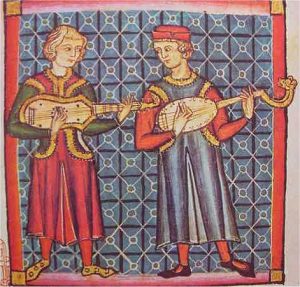
After that time it began to intermingle instruments such as the vihuela, which was well established in Spain, as opposed to the rest of Europe, where was more prevalent the lute and five order guitars.
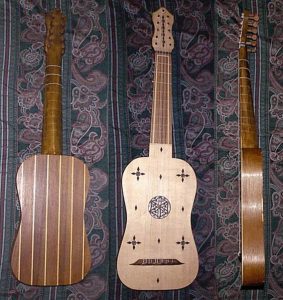
Guitar and vihuela were similar, sometimes they differed in the number of strings or tuning, ultimately, the vihuela and guitar categories are not clearly defined, probably differed in their social repercussions. The vihuela was considered an aristocratic instrument of mythological origin and the guitar a humbler instrument and its social role was inferior to vihuela.
The oldest preserved guitars are from the sixteenth century, its string length is less than the current, and most are from Italy. The Spanish guitars were considered of most “popular” purpose, they were played more often and so it was more difficult to last until our times.
Musical tastes at that time were changing and by the end of the seventeenth century, the guitar was popularized and continued to grow in Italy, France or Germany in the baroque context of that time
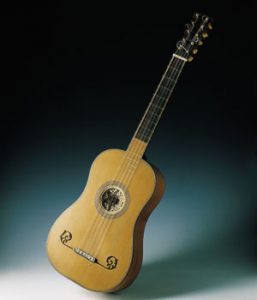
The instrument making at that time had things in common in all territories although there were peculiarities in each area, for example, usually the Italian guitars and other European had more ornaments and the Spanish ones, often had less ornamentation.
The oldest preserved guitars are from the sixteenth century, its string length is less than the current, and most are from Italy.
The sixth string was added to the guitar in the eighteenth century, attributed to Jacob Otto. The changes persisted for many years giving us a period of a great variety of forms and mechanisms on guitars until the nineteenth century when the soundboard starts to become larger, the number of frets increased, add some ebony or rosewood reinforce in the neck, while machine screws were inserted into the tuning pegs.
The sixth string was added to the guitar in the eighteenth century, attributed to Jacob Otto.
Another important development in guitar at that time was the inclusion of bars below the soundboard, to strengthen the structure of the box and allowed luthiers to reduce thicknesses and thereby obtain a higher volume of sound until its actual shape and characteristics as classical guitar.
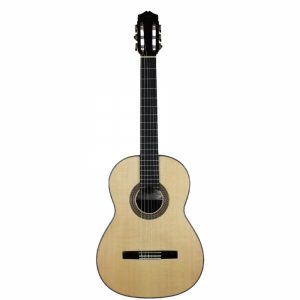
Guitar, like stringed instrument, not just like classical guitar, had many changes during the twentieth century, with the emergence of different musical genres like jazz, blues or rock that led to the new types of guitars such as acoustic guitars, with steel strings, or electric guitars with electromagnetic pickups. The history of these other types of guitars are available in their respective sections, acoustic guitar and electric guitar.


















